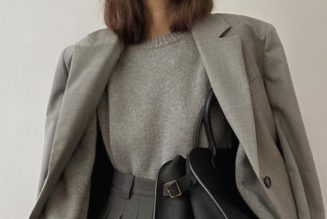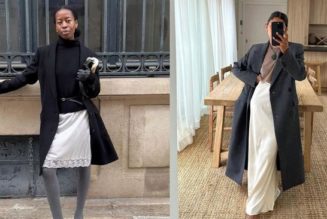
Many smaller jewelry brands incorporate details that become signatures. “It’s kind of a hidden, secret club,” one retailer said.
To a wide range of consumers, certain motifs — such as the Elsa Peretti bean from Tiffany & Company or the clover-shaped Alhambra from Van Cleef & Arpels — are as emblematic of those large luxury brands as a blatant logo.
Many lesser-known jewelry lines also have similarly recognizable details — like a particular recurring shape or style of enameling — that are easy to spot, even if only by a considerably smaller group of fashion-aware cognoscenti.
“It’s kind of a hidden, secret club,” said Laura Kay, the owner of Tomfoolery London, a boutique that specializes in tastemaker jewelry brands like Ruth Tomlinson and Artemer.
“It’s a little bit like a cult following,” she added. “People feel like they’re part of ‘If you know, you know.’”
Nancy Cuocci, a publicist in New York City, frequently wears a necklace with that type of appeal: an 18-karat-gold locket by the French jeweler Marie Lichtenberg that she has had for about a year. It does not have a logo, but the necklace’s distinctive hexagonal shape and decorative etching unmistakably convey to those familiar with the line that it is a Lichtenberg piece.
“When you see someone else wearing it, you’re like, ‘Oh, kind of similar taste levels,’” she said in a phone interview.
The necklace has a different allure, Ms. Cuocci said, from something that is popular with a larger group of jewelry lovers.
“The Love bracelet’s a perfect example,” she said, referring to Cartier’s popular gold oval with tiny screws, “where I’m like, ‘That’s a lovely piece to have, but you sort of feel like everyone has it.’ I don’t feel like it’s something that I necessarily want to splurge on.”
On the other hand, she added, her locket “feels a little special.”
Part of the appeal of these distinguishable niche brands certainly seems to be their lack of extensive advertising, global boutiques or ownership by a large corporation.
“I think it’s worked because it was not branded and it was genuine,” Ms. Lichtenberg, the necklace’s designer, said from her studio in the St.-Germain-de-Prés neighborhood of Paris. A former fashion magazine editor who was “fed for years about logos and branding,” she said that her four-year-old line didn’t feel like “LVMH or any big, big group is behind the product,” referring to the luxury-goods conglomerate.
Recognizable jewelry from independently owned brands comes in many shapes and sizes. Take Ted Muehling, a New York-based designer whose earthy work includes drop earrings in stones such as turquoise, blue chalcedony, lapis lazuli and chrysoprase. Fans say details like each stone’s cut and the distinctive flourish on the curved ear wires of his earrings make his pieces identifiable.
The English designer Alice Cicolini, whose work is sold by retailers like Dover Street Market, uses characteristic elements such as cold lacquer in her jewelry. And Polly Wales, a brand carried by Ms. Kay’s London store, includes similarly distinctive pieces with brightly colored sapphires in unconventional shapes and settings.
For many small brands, those detectable details are key. As the Copenhagen-based jeweler Sophie Bille Brahe put it, “I don’t think that it would have any success unless it had this kind of recognizable element.”
Sometimes distinctive jewelry is a bit sassy. Anissa Kermiche, who is based in London, designs pieces like her Le Derrière necklace, a dangling sculpture of a woman’s bare bottom rendered in gold-plated silver. Her collection also includes pendants that depict naked female breasts and a stud earring with a raised middle finger.
“It became recognizable because it’s attracted a certain type of people who appreciate maybe looking different or edgy, or want something to bring something different in their style or their outfit,” Ms. Kermiche said. “It kind of created a community.”
The commonality is, according to experts, a key part of the allure of recognizable small fine-jewelry brands.
“Luxury consumers have two goals: One is, they want to belong to a club, if you like, but they also want to differentiate themselves from others,” said Ravi Dhar, who is a professor of management and marketing at the Yale School of Management, director of its Center for Customer Insights and a behavioral scientist.
Wearing luxury items without bold, widely known logos, he added, “allows people to signal to others that are more in the know and sophisticated.”
“Who can recognize it? Some people can, and the people who can recognize it are also the more sophisticated ones,” he said.
Patrizia Calefato is a professor of sociology of culture at the University of Bari in Italy and the author of several books on the semiotics of fashion. “Maybe this is a new version of contemporary luxury that is cultural exclusiveness,” she said, noting that jewelry worn just as a status symbol has become less fashionable in the past decade or so.
Instead, especially since the start of the coronavirus pandemic, consumers are “looking in jewelry for something that has a cultural dimension,” she said, “that is storytelling.”
Part of that story, for some jewelry wearers, is being among a select few.
When Reina Honts, a former fashion executive who lives in Greenwich, Conn., first got her Foundrae necklace about five years ago, the brand was not well known outside of creative circles.
“Once the celebrities kind of jumped on it, it became so hot, almost to the point of ‘I don’t want to wear mine too much,’” she said. “I’m like, ‘Everybody has one now.’”









